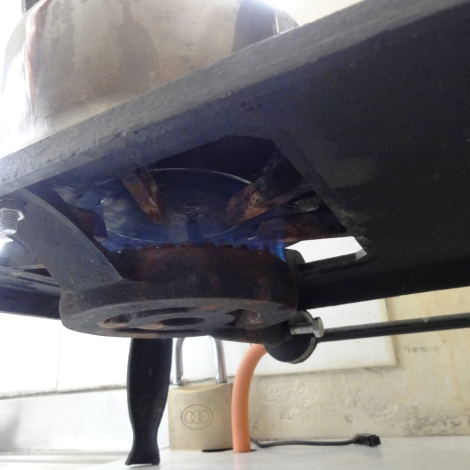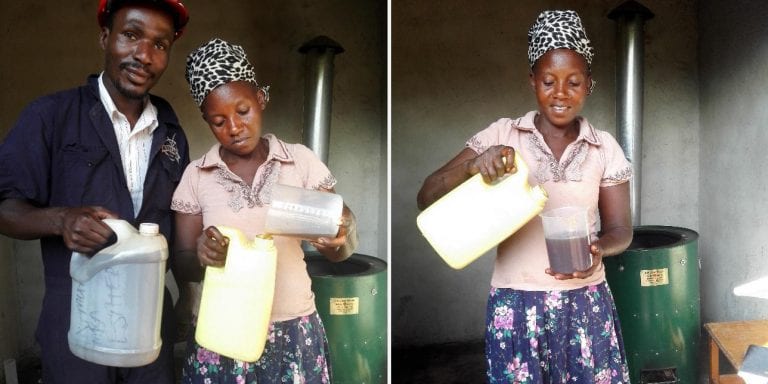The authors’ research at the Indian Institute of Technology, Delhi, has led to a method for bottling biomethane made from organic waste. The finished product can be used as fuel for transport and cooking.
Raw biogas vs. upgraded biogas
Biogas is typically produced by the anaerobic decomposition of organic waste. Raw biogas contains about 50–65 percent methane (CH4), 30–45 percent carbon dioxide (CO2) and traces of hydrogen sulphide and fractions of water vapor. The calorific value of biogas is proportional to that of concentrated methane. The presence of methane increases its calorific value while carbon dioxide, besides being non-combustible, restrains its compressibility thereby making it difficult to be stored in containers.
Dr. Vijay, one of this article’s co-authors, defines raw biogas as a low-grade fuel. It can be used on site where it is produced, or nearby for cooking with biogas cook stoves, or for electricity production by using it in dual-fuel or 100 percent biogas engines. Raw biogas has to be upgraded to natural gas quality in order to be used in vehicles that are designed to use natural gas. And it has to be bottled so that it can be transported to different locations.
Upgrading widens the scope of usage of biogas. Raw biogas with a methane content of 50 percent has a heating value of 21MJ/m3, while upgraded biogas with methane content of more than 90 percent has a heating value of approximately 35MJ/m3, which makes upgraded biogas better suited for use in higher-value applications such as transport and cooking.
Upgraded bottled biogas is an important renewable fuel; it is an environmentally friendly, clean, cheap and versatile fuel that helps in both waste management and building a sustainable environment. Bottled biogas can be easily dispensed through the natural gas infrastructure already present in India.
India’s current production of biogas is a fraction of its potential
Dr. Vijay and his research team at IIT Delhi have estimated a potential generation of biogas of approximately 48.3825 billion m3 per year, which is equivalent to 54 million m3 per year, or 24 million kg per year, of upgraded biogas in India. Following is a summary of India’s current biogas production and its vast potential.
Rapid industrialization and a population explosion in India have led to the generation of thousands of tons of organic waste in India. There are numerous cattle farms, dairies, and village communities with a large number of cattle generating dung having a potential for producing biogas at different scales. Organic waste is generated in canteens, hostels, community toilets, industries like distilleries, food processing, pulp and paper, sewage treatment plants and landfills. As per Energy Statistics 2013, India could potentially build 12 million family biogas plants around the country, and it has built 4.5 million family plants since December 2012.
More than 4000 Community Biogas Plants, Institutional Biogas Plants, and Night-Soil-Based Biogas Plants had been installed in India till 2004. There are around 300 distilleries throughout India which collectively have a potential of producing 1.2 billion Nm3 of biogas, and 2000 tannery units capable of producing 787,500 Nm3 of biogas. The increasing number of poultry farms also adds to biogas productivity, as with the current population of 649 million birds, another 2.173 billion Nm3 of biogas can be generated.
As per the Report of Planning Commission on Development of Biofuels published by the Government of India in 2013, an estimated area of 13.4 million hectares of marginal land and wastelands are suited to growing Jatropha, and this can cater to large-scale plantings so as to meet the blending targets fixed by the government of India. Non-edible seed cake produced after the extraction of biodiesel has higher potential to produce biogas compared to dung slurry, which has high water content (in excess of 90%) and leads to relatively low specific methanogenic capacities.
Bottled biogas
Bottling biogas broadens its applications. Dr. Vijay and his team developed an automated biogas upgrading and bottling system. A 10 m3/h water scrubbing based biogas upgradation and bottling system is in operation at IIT Delhi. The bottling part of the upgrading plant consists of a multi-stage high pressure compressor having suction at 0.5 bar, discharge pressure 200 bar and capacity 5 Nm3 hour; and a two-cylinder cascade. Filters are used for moisture removal. The storage cylinders used are high pressure standard CNG cylinders with a water volume of 120 (2×60) liters capacity. A CNG dispensing cable and a nozzle to NZS standards is used for filling the gas into the vehicles.
Biomethane in vehicles
The scope of utilization of biomethane as a vehicular fuel in India can be understood by the growth of infrastructure for compressed natural gas (CNG) in India. Although natural gas is not yet a major transportation fuel in India, the use of CNG is a key step toward the goal of using upgraded biogas in transportation. Since conversion for biogas use is the same as for natural gas use, upgraded biogas can be easily substituted in existing natural gas vehicles and infrastructure currently available in the country.
Cooking with upgraded biogas
There is a huge market for cooking fuel in India apart from using upgraded biogas for captive use. In India, upgraded biogas can be adopted as a cooking fuel in rural small-scale restaurants called dhabas, highway restaurants, hotels, and restaurants in urban areas, community kitchens in temples and marriage halls, roadside eating joints, etc.
Research is ongoing, seeking to make biogas more practical and usable in India. The result will be a more efficient use of organic waste and a cheap, clean fuel for cooking and transportation.
About the Authors
Professor Virendra Kumar Vijay is a Contributing Editor at Engineering for Change and works in the Centre for Rural Development and Technology (CRDT), IIT-Delhi.
Rimika Kapoor is a Post-Doctoral Fellow at CRDT, IIT Delhi.


The group should work the whole chain from bio-waste to bio-gas to biomethane. For example, they should work with Indian Railways where they collect human waste from millions of passengers regularly. The first step is the development of technology, which should be followed with logistics and business model. Then, the model can be transferred to rural bio-waste.
Dr. Vijay, it’s great to hear that you’ve developed an way to bottle biogas. A while back a couple of us ran some calculations to bottle biogas and found that it was cost prohibitive to do this. Does your process change that? Does it provide a positive ROI?